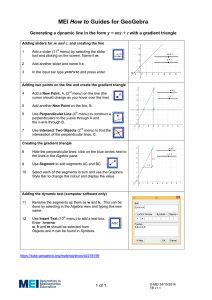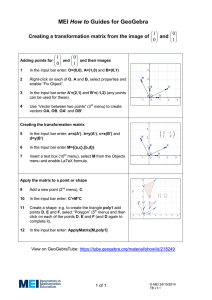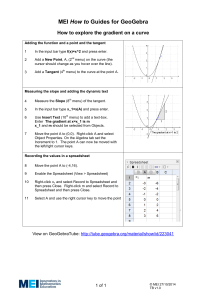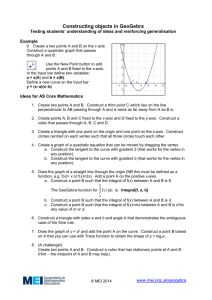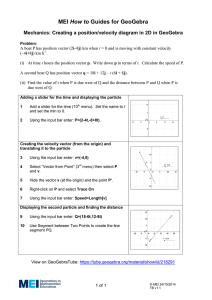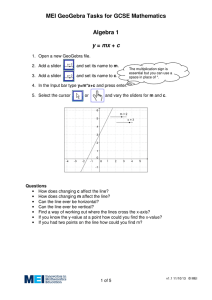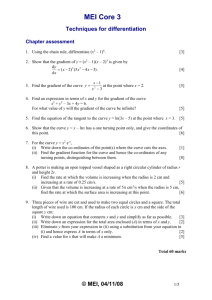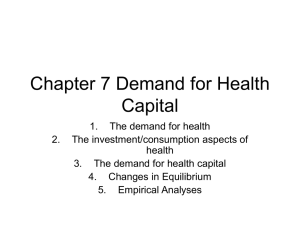MEI GeoGebra Tasks for AS Core Task 1: Coordinate Geometry
advertisement
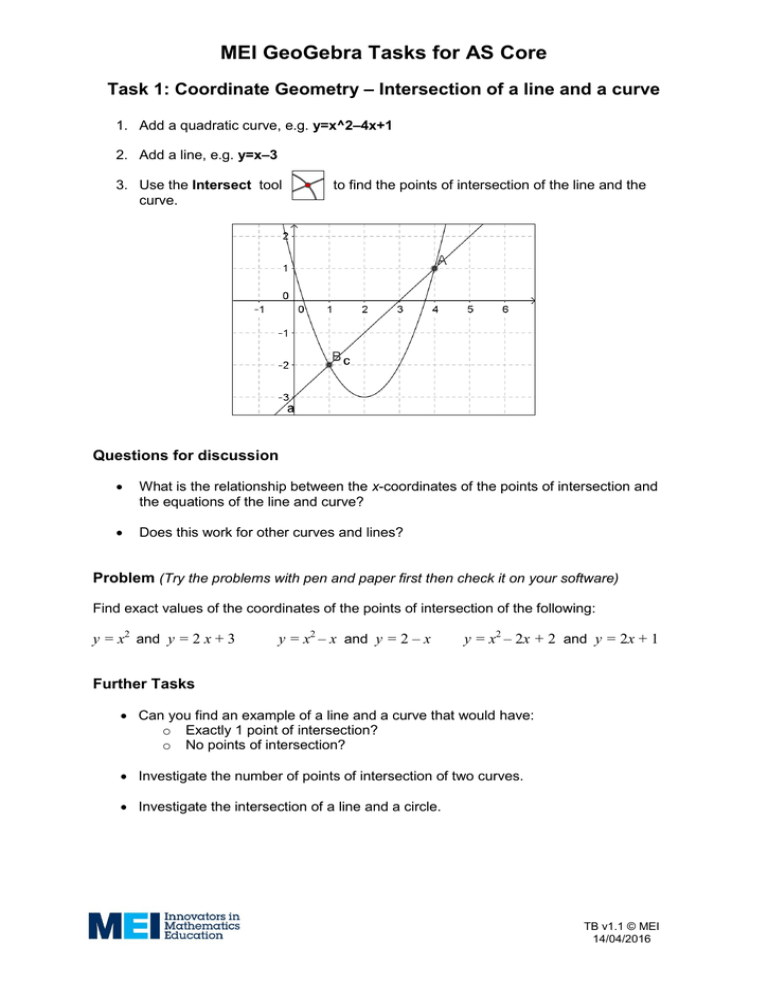
MEI GeoGebra Tasks for AS Core Task 1: Coordinate Geometry – Intersection of a line and a curve 1. Add a quadratic curve, e.g. y=x^2–4x+1 2. Add a line, e.g. y=x–3 3. Use the Intersect tool curve. to find the points of intersection of the line and the Questions for discussion What is the relationship between the x-coordinates of the points of intersection and the equations of the line and curve? Does this work for other curves and lines? Problem (Try the problems with pen and paper first then check it on your software) Find exact values of the coordinates of the points of intersection of the following: y = x2 and y = 2 x + 3 y = x2 – x and y = 2 – x y = x2 – 2x + 2 and y = 2x + 1 Further Tasks Can you find an example of a line and a curve that would have: o Exactly 1 point of intersection? o No points of intersection? Investigate the number of points of intersection of two curves. Investigate the intersection of a line and a circle. TB v1.1 © MEI 14/04/2016 MEI GeoGebra Tasks for AS Core Task 2: Coordinate Geometry – Perpendicular lines 1. Use New Point (2nd menu) to add a point, A. 2. Use New Point (2nd menu) to add a point, B. 3. Use Line (3rd menu) to create the line through A and B. 4. Use New Point (2nd menu) 5. Use Perpendicular Line (4th menu) perpendicular to the line AB. to add a point, C. Click on the point C and then the line. to create the line through C and You can display the gridlines by clicking the gridlines icon in Graphics style bar. Questions for discussion What is the relationship between the equations of the lines? What is the relationship between the equations of the lines then they are written in the form y = mx + c? Problem (Try the problem with pen and paper first then check it on your software) Show that the line perpendicular to the line through (5,1) and (1,3) that passes through the point (3,4) has equation y = 2x – 2. Further Tasks For two points A and B what are the possible positions for C so that the line through C is a perpendicular bisector? For three points A, B and C find the point of intersection of the two lines. TB v1.1 © MEI 14/04/2016 MEI GeoGebra Tasks for AS Core Task 3: Algebra – Graphs of quadratic functions 1. Use New Point (2nd menu) 2. In the input bar enter: a=x(A) b=x(B) to add two new points on the x-axis, A and B. Enter these separately and press enter after each one. 3. In the input bar enter: y=(x-a)(x-b) 4. Use New Point (2nd menu) to add a new point (not on either axis), C. 5. In the input bar enter: p=x(C) q=y(C) Enter these separately and press enter after each one. 6. In the input bar enter: y=(x-p)^2+q You can display the gridlines by clicking the gridlines icon in Graphics style bar. Questions for discussion Can you find positions for A, B and C so that the two graphs are the same? What is the relationship between the values of a, b, p and q when the graphs are the same? Problem (Try the problems with pen and paper first then check it on your software) Solve the equation x² – 2x – 8 = 0 by both factorising and completing the square. Further Tasks Add a Slider (11th menu) and set its name to k. Change the equation in step 7 to y=k(x-p)^2+q Where does this curve cross the x-axis? Can you change the equation in step 4 so the curves are the same? TB v1.1 © MEI 14/04/2016 MEI GeoGebra Tasks for AS Core Task 4: Algebra – The Factor Theorem 1. Input the function f(x)=x^3-2x^2-x+2 2. Enable the spreadsheet: View > Spreadsheet 3. In column A enter the values –3, –2, –1, 0 , 1, 2, 3, 4 4. In Cell B1 enter =f(A1) and fill-down. Questions for discussion How do this table and graph confirm that x³ – 2x² – x + 2 = (x + 1)(x – 1)(x – 2)? Can you find the factors of the following cubics: y = x³ + 4x² + x – 6 y = x³ – 4x² – 11x + 30 y = x³ – x² – 8x + 12 y = x³ – 7x² + 36 Problem (Try the question with pen and paper first then check it on your software) Show that (x – 2) is a factor of f(x) = x³ + 4x² – 3x – 18. Hence find all the factors of f(x). Further Tasks Find examples of cubics that only have one real root. Investigate using the factor theorem for polynomials of other degrees, e.g. quadratics or quartics. Investigate the Factor and Expand commands in the CAS view. TB v1.1 © MEI 14/04/2016 MEI GeoGebra Tasks for AS Core Task 5: Functions – Transformations 1. Use Slider (11th menu) to create sliders for a and b. 2. In the Input bar enter: f(x)=x^2 It is essential that this is entered as a function f(x). 3. In the Input bar enter: g(x)=f(x+a)+b Questions for discussion What transformation maps f(x) onto g(x)? Does this work if other functions are entered for f(x)? Problem (Try the problem with pen and paper first then check it on your software) Show that (x+2)3 + 3 = x³ + 6x² + 12x + 11. Hence sketch the graph of y = x³ + 6x² + 12x + 11. Further Tasks Show that f(x) = x4 – 8x³ + 24x² – 32x + 13 can be written in the form (x+a)4 + b and hence find the coordinates of the minimum point on the graph of y = f(x). Create sliders for c and d. In the Input bar enter: h(x)=c*f(d*x). What transformation maps f(x) onto h(x)? Changing f(x) to f(x)=x³–x might help make it clearer. TB v1.1 © MEI 14/04/2016 MEI GeoGebra Tasks for AS Core Task 6: Differentiation – Exploring the gradient on a curve 1. In the input bar enter a cubic function: e.g. f(x)=x^3-2x^2-2x+2 2. Use New Point (2nd menu) to add a point on the curve. 3. Use Tangent (4th menu) to create a tangent to the curve at point A. 4. Use Slope (8th menu) to measure the gradient of the tangent. 5. Plot the gradient function by entering g(x)=f '(x) in the input bar. You might find it easier to see if you change the gradient function to a dotted line using the Graphics Styling bar. Question for discussion How is the gradient of the tangent (as the point moves) related to the shape of the gradient graph? Verify your comments by trying some other functions for f(x). Problem Change your function in GeoGebra so that is has the following gradient functions: Extension Task Find the point on the function f( x) x3 6 x 2 9 x 1 where the tangent has its maximum downwards slope. Investigate the point with maximum downward slope for other cubic functions. TB v1.1 © MEI 14/04/2016 MEI GeoGebra Tasks for AS Core Task 7: Differentiation – Stationary points 1. In the input bar enter a cubic function: e.g. f(x)=x^3-2x^2-2x+1 2. Find the turning points of the function: - UK software: in the input bar enter TurningPoint[f] - Tablet/web app: in the input bar enter Extremum[f] 3. Plot the gradient function by entering g(x)=f '(x) in the input bar. You might find it easier to see if you change the gradient function to a red dotted line using the Graphics Styling bar. Question for discussion How can you use the graph of the gradient function to explain why the function has a local maximum at A and a local minimum at B? Verify your comments by trying some other functions for f(x). Problem (Try this on paper first then check the answer on your software) For the following curves plot the graphs and their derivatives. Use the derivative graph to find where the curve has a maximum or minimum: y = x2 + 4x + 1 y = 4 – 6x – x2 y = x3 – 3x y = x3 – 3x2 + 3x Extension Task Use GeoGebra to find the gradient function of f( x) x3 6 x 2 12 x 5 . Explain why the function has a stationary point that is neither a maximum nor a minimum (a stationary point of inflection). Find some other functions that have stationary points of inflection. TB v1.1 © MEI 14/04/2016 MEI GeoGebra Tasks for AS Core Task 8: Integration – Area under a curve 1. In the Input bar enter: f(x)=x^2 2. Use Slider (11th menu) It is essential that this is entered as a function f(x). to create a slider for a. 3. In the Input bar enter: A=Integral[f, 0, a] Create the slider with minimum value 0. Questions for discussion What is the relationship between the area and the value of a? What is the relationship if f(x) is changed to a different power of x? Problem (Try the problem with pen and paper first then check it on your software) Find the area under f(x) = x5 between x = 0 and x = 3. Further Tasks Add a Slider (11th menu) for b. Investigate the area under f(x)= x between x = a and x = b. Investigate the areas under functions that are the sums of powers of x: e.g. f(x)=x³ + 3x² + 4x +1 n TB v1.1 © MEI 14/04/2016 MEI GeoGebra Tasks for AS Core Task 9: Trigonometry – Trigonometric equations The degrees sign can be found in the α menu in the input bar: 1. Enter the function: f(x)=sin(x°) 2. Use Move Graphics View to set the x-axis to have a range -360 < x < 720 (dragging the x-axis should allow you to change it without affecting the y-axis) 3. Add a Slider and name it k 4. Enter the function: g(x)=k 5. In the input bar enter: Intersect[f, g, -360, 720] Questions for discussion What symmetries are there in the positions of the points of intersection? How can you use these symmetries to find the other solutions based on the value of sin-1x given by your calculator? (This is known as the “principal value”.) Problem (Try the question just using the sin-1 function on your calculator first then check it using the software) Solve the equation: sin x = 0.2 (–360° ≤ x ≤ 720°) Further Tasks Investigate the symmetries of the solutions to cos x = k and tan x = k. Investigate the symmetries of the solutions to sin 2x = k. TB v1.1 © MEI 14/04/2016 MEI GeoGebra Tasks for AS Core Task 10: Exponentials and logarithms – Graph of y = ka 1. Use the Slider tool x to add two sliders named a and k 2. Enter the function: f(x)=k*a^x 3. Use the Slider tool to add a slider named p 4. Enter the points: A=(p,f(p)) and B=(p+1,f(p+1)) Questions for discussion How does varying k affect the curve? How does varying a affect the curve? Why is it sensible to restrict a to positive values? What is the relationship between the y-coordinates of the points A and B? Problem (Try the problem with pen and paper first then check it on your software) The function y ka x passes through the points (1,10) and (3,160) . Find the values of a and k. Further Tasks Investigate solving ka x b graphically and by using logs. Use the graph of y a x to explain why a m n a m a n . TB v1.1 © MEI 14/04/2016 MEI GeoGebra Tasks for AS Core Task 11: Sequences/Series – Sum of an Arithmetic Progression 5 Example: 2n 1 . n 1 1. Input the function f(x)=2x+1 2. Enable the spreadsheet: View > Spreadsheet 3. In column A enter: 1, 2, 3, 4, 5 4. In Cell B1 enter =f(A1) and fill-down 5. In Cell C1 enter =Sum(B1:B5) Now find the sum of the terms of some other arithmetic progressions. Questions for discussion Why will the terms of bn+c (for n = 1,2,3,…) be an arithmetic progression (AP)? How can you express the link between the terms of an AP and its sum? Problem (Try the question with pen and paper first then check it on your software) What is the first term of an arithmetic progression if the 3rd term is 11 and the sum of the first 10 terms is 185? Further Tasks Investigate arithmetic progressions with the same sum, e.g. how many APs can you find that have a sum of 100? Express the nth triangle number as the sum of an AP. Investigate whether the nth hexagonal number can be expressed as the sum of an AP. TB v1.1 © MEI 14/04/2016 MEI GeoGebra Tasks for AS Core Task 12: Sequences/Series – Sum of an Geometric Progression 5 Example: 3 2 n n1 1. Input the function f(x)=3*2^x 2. Enable the spreadsheet: View > Spreadsheet 3. In column A enter: 1, 2, 3, 4, 5 4. In Cell B1 enter =f(A1) and fill-down 5. In Cell C1 enter =Sum(B1:B5) Now find the sum of the terms of some other geometric progressions. Questions for discussion Why will the terms of b×cn (for n = 1,2,3,…) be a geometric progression (GP)? How can you express the link between the terms of a GP and its sum? Problem (Try the question with pen and paper first then check it on your software) What is the common ratio of a geometric progression if the 2nd term is 30 and the sum of the first 6 terms is 3640? Further Tasks Investigate the sums of geometric series where the common ratio is negative and/or less than 1. Investigate how savings or loans can be expressed as the sum of a geometric progression. TB v1.1 © MEI 14/04/2016 MEI GeoGebra Tasks for AS Core Teacher guidance Task 1: Coordinate Geometry – Intersection of a line and a curve This task can be used to introduce the intersection of a line and a curve. Students should consider the equation formed by subtracting the linear function from the quadratic and observing its roots. Some students might find it helpful to plot this. Problem solutions: y = x2 and y = 2 x + 3 (–1, 1) and (3, 9) y = x2 – x and y = 2 – x (–2, 4) and (1, 1) y = x2 – 2x + 2 and y = 2x + 1 (–√3+2, –2√3+5) and (√3+2, 2√3+5) Task 2: Coordinate Geometry – Perpendicular lines The equations of the lines will appear in the form ax + by = c. Students should try rewriting these in the form y = mx + c or get the software to do it automatically (right-clicking on the equations). The equations of the perpendicular lines will have the coefficients written in decimal form and it might be helpful to discuss with students why writing these a fractions is preferable in some circumstances. Problem solution: The perpendicular line has equation y = 2x – 2. Task 3: Algebra – Graphs of quadratic functions Students should attempt to solve some quadratic equations by completing the square and then making x the subject. Students might find it helpful to observe the line of symmetry of the curve or the relationship between the completed square solution and solving with the standard formula. Problem solution: x² – 2x – 8 = 0 (x – 4)(x + 2) = 0 x = 4 or x = –2 (x – 1)² – 9 = 0 x = 1± 3 x = 4 or x = –2 Task 4: The Factor Theorem This task is intended to reinforce the link between the numerical values of roots, algebraic factors and points of intersection with the x-axis. In discussions students should be encouraged to explain how both the table and the graph indicate what the factors are. It might be useful for some students to practise expanding products of three factors before attempting this task. Students will also need to be shown, or to develop, strategies for dividing by a factor, such as equating coefficients, long division or division by the box method. TB v1.1 © MEI 14/04/2016 MEI GeoGebra Tasks for AS Core Questions: y = x³ + 4x² + x – 6 : y = x³ – 4x² – 11x + 30 y = x³ – x² – 8x + 12 y = x³ – 7x² + 36 y = (x – 1)(x + 2)( x + 3) y = (x – 5)(x – 2)(x + 3) y = (x – 2)² (x + 3) y = (x – 6)(x – 3)(x + 2) The third question can be used to demonstrate an example of a cubic with a repeated root. Problem solution: x³ + 4x² – 3x – 18 = (x – 2)(x + 3)² Task 5: Functions – Transformations If students have met trigonometric functions then these work well for this task. For the problem students should expand the function using either a binomial expansion or by multiplying out the brackets. 2 . 3 The graph of the function is the graph of f( x ) x 3 translated by Be careful with second further task (horizontal stretches) – they can look like vertical stretches for many functions but this is an excellent discussion point. Students should also take care with the scales on the axes here as these can cause confusion. f( x) sin x or f( x) x 3 x are good functions to use for this. Task 6: Differentiation – Exploring the gradient on a curve The aim of this task is for students to investigate (or verify if they have already met it) the shape of derivative functions. They should be encouraged to discuss why the derivatives have the shape they do in terms of the gradient of the tangent to the curve at different points. It can be used as an introduction to the topic or to consolidate what they have already learnt. Problem solution (possible solutions): f( x) x3 2 x f( x) x 2 f( x) x 4 2 x 2 Task 7: Differentiation – Introduction to Stationary Points This task highlights the link between the derivative and determining the nature of stationary points on curves. Problem solutions: y = x2 + 4x + 1 min: (–2, –3) y = 4 – 6x – x2 max: (–3, 13) y = x3 – 3x min: (1, –2) max: (–1, 2) y = x3 – 3x2 + 3x no maxima or minima The final example can be used to discuss stationary points that are points of inflection and this can lead into the extension tasks. TB v1.1 © MEI 14/04/2016 MEI GeoGebra Tasks for AS Core Task 8: Integration – Area under a curve The aim of this task is for students to investigate (or verify if they have already met it) the rule for integrating/finding the area under polynomials. It can be used as an introduction to the topic or to consolidate what they’ve already learnt. Problem solution: The area is 20.25. The first of the further tasks is an opportunity for students to investigate: b b a a 0 0 f( x)dx f( x)dx f( x)dx . Task 9: Solutions of Trigonometric Equations (Degrees) This task encourages students to think about the symmetries of the trigonometric graphs and use these in finding solutions to equations. Students should be familiar with scaling one of the axes independently by either dragging the axis (as in instruction 2) or by setting it via the Graphics properties. Problem solution: x = –348.46°, –191.54°, 11.54°, 168.46°, 371.54°, 528.46°. Task 10: This task allows students to investigate exponential functions of the form y = kax. The points A and B encourage students to focus on the growth factor as a multiple when increasing the value of x by 1. Problem solution: y 2.5 4 x . Task 11: Sum of an Arithmetic Progression This task reinforces the terms of a sequence and what the sigma notation is showing. Before moving on to the problem you should show the two forms of the sum of an AP. Problem solution: 5 Task 12: Sum of a Geometric Progression This task reinforces the terms of a sequence and what the sigma notation is showing. It is unlikely that many students will be able to derive a general formula for the sum of a GP without assistance. You will need to show them the sum of a GP before they attempt the problem and you can link their observations to the formula and discuss whether they are consistent with it. Problem solution: 3 TB v1.1 © MEI 14/04/2016
